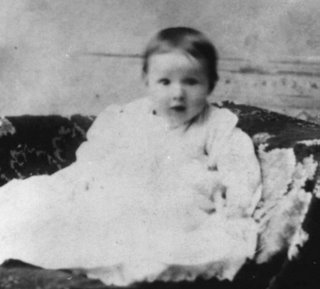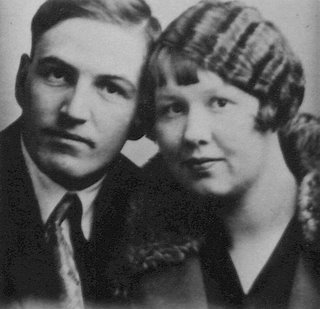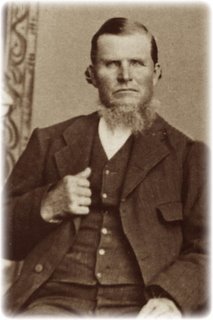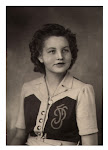 A very early photo taken in Logan, Utah showing the youthful couple, William E. Jenkins and Emma Rosetta Lusk.
A very early photo taken in Logan, Utah showing the youthful couple, William E. Jenkins and Emma Rosetta Lusk.
Monday, August 31, 2009
Billy Jenkins and Rose Lusk
 A very early photo taken in Logan, Utah showing the youthful couple, William E. Jenkins and Emma Rosetta Lusk.
A very early photo taken in Logan, Utah showing the youthful couple, William E. Jenkins and Emma Rosetta Lusk.
Jenkins / Lusk Photos
Monday, June 23, 2008
Zephaniah and Pheobe Jones
By Pearl Atkinson (granddaughter)
Zephaniah Jones, my grandfather, was born September 21, at Trevethin, Monmouthshire, [Wales]. He was the second son born to John and Jemina Davis Jones and had three brothers: John, Thomas and George. John was a collier and Zephaniah followed in the same trade. It was a hard life.
He married Amelia or Amy Morris on July 5,1845. They had six children: Jane, who sailed to America in 1863 and was lost crossing the plains and never heard from again; William stayed in [Wales]; Jemina and Zephaniah died in their youth in [Wales]; Amelia married LeRoy Vader; and Joseph married Emma Rosetta Lusk. They joined the Mormon Church and lived in the Trinant Branch. Amelia died December 21, 1857, at the age of 31 leaving Zephaniah the family to raise with a seven month old baby.
Zephaniah married Caroline Thomas and to this union six children were born. They sailed to the
United States on the ship Amazon and landed in New York. They crossed the plains and made their way to Willard. Caroline died and Zephaniah was left with a fifteen day old son to raise and the rest of his family.
On May 21, 1841, Pheobe was born to John E. and Margaret Edwards Davis in Tredegar,
Monmouthshire, [Wales]. At the age of ten she was baptized in the Church of Jesus Christ of
Latter-day Saints. She took a great deal of interest in the Tredegar Branch and helped in every
possible way. She grew to be a beautiful girl, five foot tall, black eyes, dark hair and a ruddy
complexion. She had a genial disposition and always tried to make the best of everything. At 21 with the consent of her parents, she sailed to America on the ship Manchester on May 6, 1862. She landed in New York and came across the plains in the Ansel [P. Harmon] Company, arriving in Salt Lake City, October 5, 1862.
Pheobe married Richard Jenkins Davis, as his plural wife, on April 18, 1863 in the Endowment
House. They lived in Willard, Utah, and seven children were born: Amelia married Ephraim Jones and died February 27, 1898 leaving eight children; Rachel died June 17, 1880 at the age of 14; John Edmond, no record; Martha and Rhoda, twins, died in infancy; Hyrum married Margaret Victoria Williams, died April 3, 1941; Evan John drowned in the Devil Creek when two years old. Phoebe separated from Richard in the early part of 1873, and their sealing was cancelled on November 22, 1873.
Zephaniah Jones and Phoebe Davis were married April 20, 1874, in the Endowment House in Salt Lake City. Phoebe also stood as proxy for Amelia and Caroline to be sealed. Shortly after they moved with their families to the Malad Valley. They were members of the St. John Ward.
They built a log home in the middle of the Valley and also farmed and had a dairy in the Dairy Creek area. Four children were born to them: Albert Davis Jones, born September 22, 1875, married Margaret Fairlie Jenkins February 10, 1904, and died October 9, 1921; George W. Jones was born November 3, 1877, married Lillian Perry March 27,1902, and died December 7, 1941; Phoebe Caroline Jones was born January 14, 1880, married William Hill, and died June 21, 1943; and Samuel Davis Jones, born May 7, 1882, married Hannah May Williams, March 23, 1904, and died December 9, 1929.
On the homestead up at Dairy Creek they had a complete dairy with water wheel, cheese room and corrals. They made cheese and butter and Zephaniah would haul the products to market in a
wagon. Phoebe would come to Malad in a buggy and sell cheese and butter to buy what she needed for her household. They probably lived at Dairy Creek in the summer and in the Valley in the winter.
Zephaniah was deaf in his later years. He had a health problem for quite awhile and passed away
June 11, 1883, at the age of 59 and was buried in the St. John Cemetery. The early pioneer women were not afraid to work and Phoebe was no exception. She was a religious
woman and with all her household duties she found time to attend to her church work. She worked in the St. John Relief Society for twelve years, as 1st Counselor for one year and President for eleven years. She bore her testimony often and loved God.
At age 57 her daughter Amelia died leaving eight children, the 'youngest 14 days. She gave them
her best and they all loved her. She passed away February 26, 1912, in Malad and was buried by
the side of Zephaniah in the St. John Cemetery. She left a host of relatives and friends.
(From St. John, Oneida County, Idaho: A collection of personal histories from the time of the first settlers to the present day, pp. 177-178.)
Wednesday, May 21, 2008
Irene Jones Jenkins
Life Sketch of Irene Louise Jones Jenkins

Irene Louise Jones was born
The young couple lived in various cities and towns in southeastern
The earthly marital union of Irene and Wallace Jenkins has withstood the trials and tribulations of over 48 years. This fact alone, is indicative of the love and devotion they both felt for each other.
Along with this love, they had a great respect for one another; assisting each other through personal problems, and also rejoicing together during times of happiness; and if she were able, she’d tell us that the times of happiness occurred more often than the other times.
One of the highlights of her life has been that she was able to live in
Irene has suffered much physical illness throughout her life, but her faith in her religion , and her bravery have made all of those illnesses easier for all of her family to withstand.
Her most recent illness, which has kept her bedridden for quite some time, has been a strain on her husband and members of the family. The constant vigil, that was kept by her husband, her daughters, and other members of the family, again expresses their sincere love and devotion for Irene Jenkins.
John Winters Lusk
(Written by Catherine Lusk Reynolds, Jan. 26, 1935)
John Winters Lusk was born June 12, 1829, in
He married again on March 4, 1854, at
He married the third time on Jan. 20, 1859, in
John Winters Lusk was one of the early pioneers of
John Lusk had two families. They lived in a dugout and two covered wagons during the first year after they came to Malad. In the fall, he started to build two log rooms, which were built together with only outside entrances to each room. The rooms had wooden floors, the roof was made by placing large willows over the entire area, then covering that with straw, and finally a layer of dirt.
The night they moved in, Esther gave birth to a baby boy. His name was David James. He was a very bright child. He died when he was fourteen years old. (he was loved by all people both young and old) They lived in this house for a number of years. Later father built a log room on the west corner of the block for Martha.
Between the two homes he built his barns and other outside buildings. In the granary father kept his tool chest. The inside of the granary was divided into sections according to different sizes of tools. These were always in order, and no one was allowed to bother them.
Each woman had cows, pigs, and chickens, which helped to make a living for the family. Father was a farmer, raising hay, grain and all kinds of fruit and vegetables. On his east lot he planted all kinds of the choicest fruit trees, namely apples of all kinds, peaches, pears, plums, raspberries, gooseberries, and currants, which were all the very best. He always had a good garden, plenty of large field squash, and corn which are seldom seen now.
He was a great lover of horses. (He always had a kettle he used for boiling wild sage, which was used for limbering joints, and curing all kinds of ailments in horses.) He owned several race horses. Sleepy Tom, a medium sized white horse, was his favorite race horse, because of being faithful to him in later life. Father once said, “Sleepy Tom knows more than the most of men.”
He owned a piece of hayland south of town, and also a few acres of wheat land near where the depot now stands. In after years he took up a quarter section, five or six miles north of town, just at the mouth of New Canyon, (now owned by Evan Evans), His land was joined on the south by the property of his sons-in-laws, the Evans brothers, and on the north by the property of another son-in-law, Henry Bolingbroke. The property of his son, John W. Lusk, joined that of Henry Bolingbroke.
Esther and Martha took turns living on the farm, one one summer and the other the next, caring for father and the boys wile they were working on the farm, They had a number cows, pigs, and chickens.
On April 22, 1882, Martha died at the age of forty, and Ester then cared for the two families, consisting of ten children, the rest being married. Later father decided to build a larger house on the east corner of the lot. The family all lived together on the west corner in Martha’s home until the new home was completed. The new home was a two story building, with five large rooms, stairway, pantry, and one large closet, at the head of the stairs.
Fastened to the ceiling of one of the large rooms up stairs were four large hooks, these were used to hold the quilting frames in place. While the quilt was not being worked upon, it was wound up on ropes to the ceiling, and the room was used for other purposes.
There they lived very happily, until Esther was called home. That was the trying time of father’s life, with five children home and no mother at the head. He kept the home together until all the children were married. He was then alone, getting old and no partner or help-mate. He sold the farm and other lands. One of the girls, Rose, and family lived with him one winter. He then lived for some weeks with Ida, another of Martha’s daughters, and also with Mary, Esther’s daughter.
His health was failing all the time. He then moved to the home of Sarah, another of Esther’s daughters. After some weeks he passed away, (and went to join his loved ones in Heaven, where I know they are all glad to meet him as he was a kind hearted father and husband.)
He was the father of eighteen children, eleven girls and seven boys, (six girls and three boys still living, on Jan. 26, 1935) He was a sturdy pioneer and went through all the hardships and trials of taking care of his family and building up a new home in a barren country. He was a true Latter Day Saint and died in full faith in the glorious resurrection.
He died on September 21, 1899, and was buried in the Malad Cemetary. (May all his children and grandchildren follow in his footsteps is the desire of one of his daughters.)
Sarah Catherine Lusk Reynolds
Jan 26, 1935
The children of John W. Lusk and Esther Catherine Park Lusk:
Mary Elizabeth Lusk Bolingbroke
John Winters Lusk
Cynthia Maria Lusk Jones
Sarah Catherine Lusk Reynolds
Martha Lucretia Lusk Jones
Matilda Lavesta Lusk Evans
David James Lusk
Perry Park Lusk
The children of Martha Tidwell and John Lusk were:
Sarah Jane Lusk Evans
William Jefferson Lusk
Emma Rosetta L. Jones Jenkins
Alma Hyrum Lusk
Elizabeth Maria L. Williams
Louisa Lusk Jones
Samuel Tidwell Lusk
Lovisa Lusk Jenkins
Joseph Tidwell Lusk
Charlotta Elmedith Lusk Koons
John and Jane Tidwell
Biography of John Tidwell
Written by Himself
John Tidwell and Jane Smith Tidwell
John Tidwell, son of William Tidwell and Sarah Goben, born January 14, 1807 in Shelby Co. Kentucky. From there my father moved to Henry county in the same state, and there near the fork of Kentucky river he was called to go and fight for the
On December 18, 1828 I was married to Jane Smith at
September 11, 1839, I left Clark county, Indiana to gather with the church at Nauvoo, Hancock county,
I must say in connection with our stay in Nauvoo, which was less than six years, we had a great deal of sickness, also trouble caused by mobs of outlaws of the state of
On June 5, 1852, I left Council Point, Southwest on
Joseph Young took the lead and afterward I was assigned to the thirty-fourth quorum of Seventies and appointed to preside over the mass quorums of
I lived at Pleasant Grove from September 20, 1852 until June 9, 1859 when I concluded to go to some place where I could get land enough for farming so as to provide for my family and also on account of things being in such an immoral state that I feared my family would get into bad habits such as I did not wish them to do. I thought I would move to some other place so I moved to
John Tidwell dies at
James Harvey
William Nelson
Mary Jane
Jefferson Lyman
Nancy Ann
Martha
Margaret
Sarah
John
EmmaJane
Emeline Mariah
Child eleven, Emma Jane was born in
Postscript by Jessie Lusk:
The immoral state mentioned above was no doubt caused by









